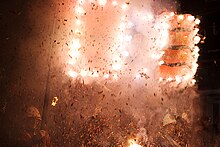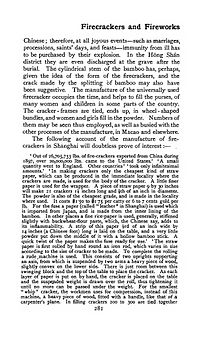Contents of firecrackers
Firecrackers are generally made of cardboard or plastic, with flash powder or black powder as the propellant. This is not always the case, however. Anything from match heads to lighter fluid have been used successfully in making firecrackers. The key to loud firecrackers, however, although in part lying in the propellant substance, is pressure. The entire firecracker must be very tightly packed in order for it to work best. Flash powder does not need to be packed tightly, however.How firecrackers were made
James Dyer Ball in his book Things Chinese has a detail description about the process and material used for making firecracker at the end of 19th century. At that time, firecrackers were made by women and children workers, using straw paper to make the body of firecracker, while the fuse was made by bamboo paper imported from Japan, then stiffen with buckwheat paste. The bamboo paper cut into strips of 14 inches long and one third of an inch wide,laid on table, a string of gun powder was placed at the center with a hol tube, then twist up to make a piece of fuse. The firecracker tubes were made from pieces of straw paper wrapped around iron rods of various diameters then tighten with special tool. 200 to 300 firecrackers were tied up in a bunch, then red clay was spread at the bottom of the bunch, and forced into each end of the firecracker with a punch, gun power was pour into it, then the other end was sealed with awl by turning the tube inward, and a fuse inserted.[1]Culture

Two men dressed as colonial soldiers carry a banner, exploding firecrackers, commemorating Guy Fawkes and his co-conspirators as part of Lewes Bonfire Night celebrations.
Legality of firecrackers
Firecrackers, as well as other types of explosives, are subject to various laws in many countries, although firecrackers themselves are not usually considered illegal contraband material. It is usually the manufacture, sale, storage, and use of firecrackers that are subject to laws including safety requirements for manufacture, the requirement of a permit to sell or store, or restrictions on the use of firecrackers.Firecracker ban
The use of firecrackers, although a traditional part of celebration, has over the years led to many injuries. There have been incidents every year of users being blinded, losing body parts, or suffering other injuries, especially during festivities that customarily involve firecrackers such as Chinese New Year season. Hence, many governments and authoritarians have enacted laws completely banning the sale or use of firecrackers, or banning the use of firecrackers in the street, primarily because of safety issues.- Australia – Australia, with the exception of its capital territory (ACT) and the Northern Territory, does not permit the use of fireworks, except by a licensed pyrotechnician. These rules also require a permit from local government, as well as any relevant local bodies such as maritime or aviation authorities (as relevant to the types of fireworks being used) and hospitals, schools, et cetera, within a certain range.
- Canada - Firecrackers are not authorized under the Explosives Act, thus making importation, possession, transportation, storage or manufacturing illegal in Canada.[2] Canada banned firecrackers on September 27, 1972 after it came out in the media that two children were killed and three others severely burned when some older children were playing with firecrackers outside their tent. False rumours have been spread that the children inside the tent had actually been smoking and, not wanting to tell their parents, had told them they had been playing with firecrackers.[3] This report is incorrect. One of the surviving burn victims has researched and documented the events of that night and has included some of these details in his autobiography.[4] Fireworks, however are still legal to buy for anyone 18 years of age or over.
- Mainland China – As of 2008, most urban areas in mainland China permit firecrackers. In the first three days of the traditional New Year, it is a tradition that people compete with each other by playing with firecrackers. However, many urban areas banned them in the 1990s. For example, they were banned in Beijing's urban districts from 1993 to 2005.[5] In 2004, 37 people were killed in a stampede when four million[6] people gathered for a rumored Lantern Festival firework display in nearby Miyun.[7] Since the ban was lifted, the firecracker barrage has been tremendous. An unusual[clarification needed] feature is that many residents in major cities look down on street-level fireworks from their tower blocks. Bans are rare in rural areas.
- Hong Kong – Fireworks are banned for security reasons – some speculate a connection between firework use and the 1967 Leftist Riot. However, the government would stage a fireworks display in Victoria Harbour on the second day of the Chinese New Year. Similar displays are also held in many other cities in and outside China.
- Indonesia – Firecrackers and fireworks are forbidden in public during the Chinese New Year, especially in areas with significant non-Chinese population to avoid conflict between the two. However, there were some exceptions. The usage of firecrackers is legal in some metropolitan areas such as Jakarta and Medan, where the degree of racial and cultural tolerance is higher.
- Italy – Firecrackers are legal and can be bought without a licence.
- Malaysia – firecrackers are banned for similar reasons as in Singapore. However, many Malaysians smuggle them from Thailand.
- Norway - The government of Norway decided to ban rockets shortly after 2009 started. Other types of fireworks are still allowed.
- Philippines – Fireworks and firecrackers are widely available throughout the Philippines, but are banned in Olongapo City (since 2008)[8] and Davao City (since 2001).
- Republic of Ireland - Fireworks and firecrackers are not permitted in the Republic of Ireland however many people smuggle them from Northern Ireland where they are legal. They are most common around Halloween.
- Singapore – a partial ban on firecrackers was imposed in March 1970 after a fire killed six people and injured 68.[9] This was extended to a total ban in August 1972, after an explosion that killed two people[10] and an attack on two police officers attempting to stop a group from letting off firecrackers in February 1972.[11] However, in 2003, the government allowed firecrackers to be set off during the festive season. At the Chinese New Year light-up in Chinatown, at the stroke of midnight on the first day of the Lunar New Year, firecrackers are set off under controlled conditions by the Singapore Tourism Board. Other occasions where firecrackers are allowed to be set off are determined by the tourism board or other government organizations. However, their sale is not allowed.
- Sweden - Only rocket type fireworks are allowed in Sweden. The ban of fire crackers was done by the EU Parliament and Swedish government 1 December 2001
- Taiwan – Beginning 2008, firecrackers are banned in urban areas, but still allowed in rural areas.
- United Kingdom - In 1997, firecrackers became illegal but most other consumer fireworks are legal.[12]
- United States – In 2007, New York City lifted its decade-old ban on firecrackers, allowing a display of 300,000 firecrackers to be set off in Chinatown's Chatham Square.[13] Under the supervision of the fire and police departments, Los Angeles regularly lights firecrackers every New Year's Eve, mostly at temples and the shrines of benevolent associations. The San Francisco Chinese New Year Parade, the largest outside China, is accompanied by numerous firecrackers, both officially sanctioned and illicit.
Firecracker brands, packs and labels
Early (pre-1920s) Chinese firecrackers (AKA Mandarin firecrackers) were typically 1/2-inch to 2-inches long, and approximately 1/4-inch in diameter, and were charged with black powder. Mandarin crackers produced a less loud, a duller thud, compared to modern flash light crackers (which utilize a different explosive known as flash powder). Mandarin crackers produced a dimmer, less brilliant flash when they exploded also. Individual Mandarin crackers were most often braided into "strings" of varying lengths, which when ignitied, exploded in rapid sequence. Generally, the strings (sometimes containing as many as several thousand crackers) would be hung from an overhead line before ignition. Most Mandarin crackers were colored all red and did not generally have designs or logos decorating their exterior surface (AKA "shell wraps"). Occasionally a few yellow and green Mandarin crackers were created and would be braided into the predominantly all red strings, to symbolize the emperor and the ruling class, while the numerous red crackers symbolized the common man.Once flash powder, which produces a significantly sharper and brighter bang, replaced black powder as a firecracker's explosive charge (circa 1924) manufacturers began competing to gain loyalty of the consumers (that is, mainly boys 8–16 years of age). Thousands of brands were created during the flash light cracker's heyday from the 1920s through the early 1970s. Only a small percentage of brands lasted more than a year or two. Collectors now seek the various labels from the era.[14]
Until the mid-1980s firecracker production was low-tech. They were handmade, beginning with rolling tubes. Once the firecracker tubes were rolled by hand (commonly from newspaper) and labelled, and then filled with powder, their ends were crimped and fuses inserted, all by hand. These finished firecrackers were usually braided into "strings" and sold in packs which came in many sizes, from the very small (called "penny packs" containing as few as 4 to 6 firecrackers) to the most common size packs (containing 16 and 20 crackers per pack), to larger packs (containing 24, 30, 32, 40, 50, 60, 72, 90, 100 and 120 firecrackers), to huge "belts" and "rolls" (packages containing strings of several hundred to several thousand crackers - Phantom Fireworks sells rolls as large as 16,000 firecrackers[15]). Firecracker packages were wrapped in colourful and translucent glassine paper, as well as clear cellophane, with glassine the most popular.
The final operation involved applying a branded label on each pack, then bundling finished packs into wholesale lots called "bricks" which contained an average of 80 packs each (varying according to the size of the packs being bundled. For example, packs of 32 crackers might have 40 packs per brick, compared to packs of 16 or 20 with 80 packs per brick).
http://en.wikipedia.org/wiki/Firecracker


No comments:
Post a Comment